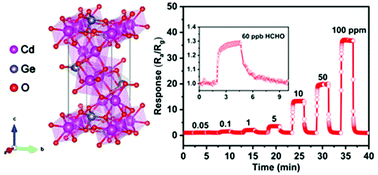Olivine-type cadmium germanate: a new sensing semiconductor for the detection of formaldehyde at the ppb level†
Abstract
Formaldehyde is the most popular and highly toxic indoor pollutants. It is very urgent to develop more sensitive formaldehyde gas sensors with remarkable sensitivity at the ppb level. In this study, for the first time, the olivine-structured Cd2GeO4 was identified as an excellent formaldehyde sensing material. The as-obtained Cd2GeO4 and other sensing materials were well characterized by XRD, SEM, TEM, XPS, scanning Kelvin probe and O2 temperature-programmed desorption techniques. The sensor based on the as-prepared Cd2GeO4 exhibits a high response of 14.1, a short response time (about 5 s) towards 10 ppm formaldehyde and a low detection limit of 60 ppb formaldehyde at a relatively low operating temperature of 140 °C, benefiting the practical application. We believe that the excellent formaldehyde sensing performance should be attributed to the rich chemisorbed oxygen, the small size and the appropriate Fermi level of Cd2GeO4. It can be expected that it will be a promising material for fabricating excellent formaldehyde gas sensors due to its unique sensing characteristics.

- This article is part of the themed collection: 2021 Inorganic Chemistry Frontiers HOT articles


 Please wait while we load your content...
Please wait while we load your content...